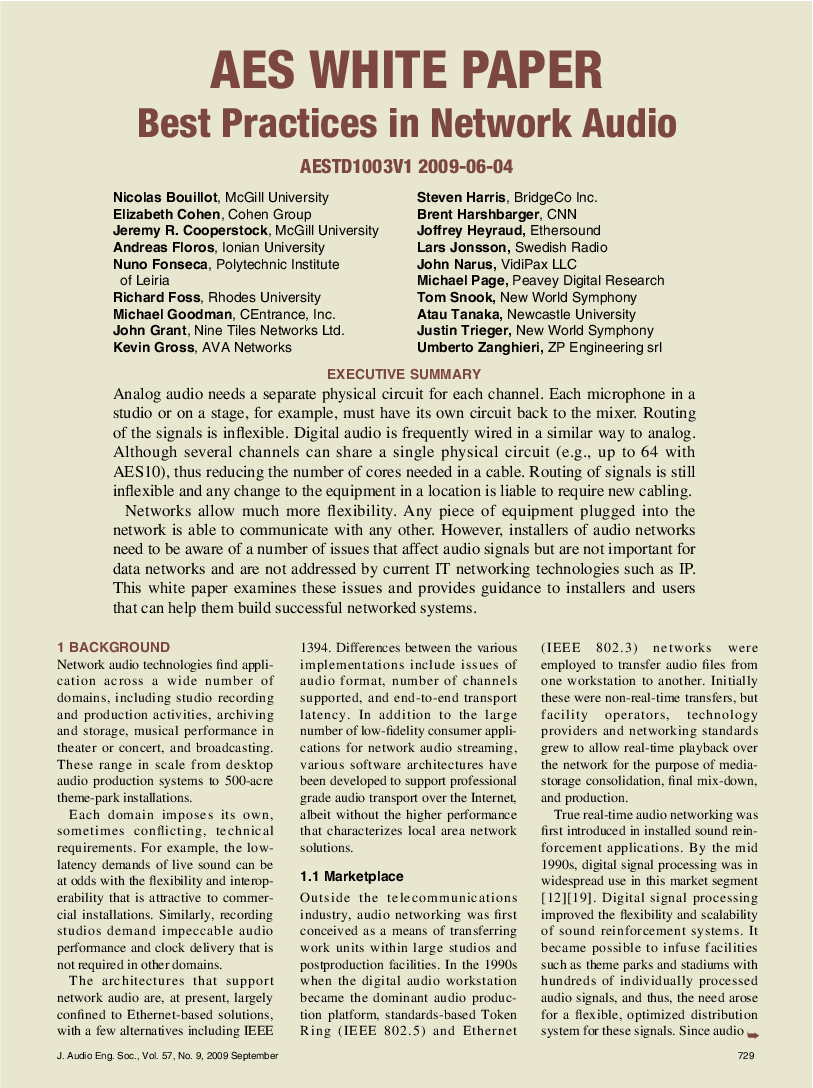Home / Publications / E-library page
You are currently logged in as an
Institutional Subscriber.
If you would like to logout,
please click on the button below.
Home / Publications / E-library page
Only AES members and Institutional Journal Subscribers can download
[Feature] Analog audio needs a separate physical circuit for each channel. Each microphone in a studio or on a stage, for example, must have its own circuit back to the mixer. Routing of the signals is inflexible. Digital audio is frequently wired in a similar way to analog. Although several channels can share a single physical circuit ( e. g., up to 64 with AES10 ), thus reducing the number of cores needed in a cable. Routing of signals is still inflexible and any change to the equipment in a location is liable to require new cabling. Networks allow much more flexibility. Any piece of equipment plugged into the network is able to communicate with any other. However, installers of audio networks need to be aware of a number of issues that affect audio signals but are not important for data networks and are not addressed by current IT networking technologies such as IP. This white paper examines these issues and provides guidance to installers and users that can help them build successful networked systems.
Author (s): Bouillot, Nicolas; Cohen, Elizabeth; Cooperstock, Jeremy R.; Floros, Andreas; Fonseca, Nuno; Foss, Richard; Goodman, Michael; Grant, John; Gross, Kevin; Harris, Steven; Harshbarger, Brent; Heyraud, Joffrey; Jonsson, Lars; Narus, John; Page, Michael; Snook, Tom; Tanaka, Atau; Trieger, Justin; Zanghieri, Umberto
Affiliation:
AES Technical Committee on Network Audio Systems
(See document for exact affiliation information.)
Publication Date:
2009-09-06
Import into BibTeX
Permalink: https://aes2.org/publications/elibrary-page/?id=14839
(359KB)
Click to purchase paper as a non-member or login as an AES member. If your company or school subscribes to the E-Library then switch to the institutional version. If you are not an AES member Join the AES. If you need to check your member status, login to the Member Portal.

Bouillot, Nicolas; Cohen, Elizabeth; Cooperstock, Jeremy R.; Floros, Andreas; Fonseca, Nuno; Foss, Richard; Goodman, Michael; Grant, John; Gross, Kevin; Harris, Steven; Harshbarger, Brent; Heyraud, Joffrey; Jonsson, Lars; Narus, John; Page, Michael; Snook, Tom; Tanaka, Atau; Trieger, Justin; Zanghieri, Umberto; 2009; AES White Paper: Best Practices in Network Audio [PDF]; AES Technical Committee on Network Audio Systems; Paper ; Available from: https://aes2.org/publications/elibrary-page/?id=14839
Bouillot, Nicolas; Cohen, Elizabeth; Cooperstock, Jeremy R.; Floros, Andreas; Fonseca, Nuno; Foss, Richard; Goodman, Michael; Grant, John; Gross, Kevin; Harris, Steven; Harshbarger, Brent; Heyraud, Joffrey; Jonsson, Lars; Narus, John; Page, Michael; Snook, Tom; Tanaka, Atau; Trieger, Justin; Zanghieri, Umberto; AES White Paper: Best Practices in Network Audio [PDF]; AES Technical Committee on Network Audio Systems; Paper ; 2009 Available: https://aes2.org/publications/elibrary-page/?id=14839
@article{bouillot2009aes,
author={bouillot nicolas and cohen elizabeth and cooperstock jeremy r. and floros andreas and fonseca nuno and foss richard and goodman michael and grant john and gross kevin and harris steven and harshbarger brent and heyraud joffrey and jonsson lars and narus john and page michael and snook tom and tanaka atau and trieger justin and zanghieri umberto},
journal={journal of the audio engineering society},
title={aes white paper: best practices in network audio},
year={2009},
volume={57},
issue={9},
pages={729-741},
month={september},}
TY – paper
TI – AES White Paper: Best Practices in Network Audio
SP – 729 EP – 741
AU – Bouillot, Nicolas
AU – Cohen, Elizabeth
AU – Cooperstock, Jeremy R.
AU – Floros, Andreas
AU – Fonseca, Nuno
AU – Foss, Richard
AU – Goodman, Michael
AU – Grant, John
AU – Gross, Kevin
AU – Harris, Steven
AU – Harshbarger, Brent
AU – Heyraud, Joffrey
AU – Jonsson, Lars
AU – Narus, John
AU – Page, Michael
AU – Snook, Tom
AU – Tanaka, Atau
AU – Trieger, Justin
AU – Zanghieri, Umberto
PY – 2009
JO – Journal of the Audio Engineering Society
VO – 57
IS – 9
Y1 – September 2009